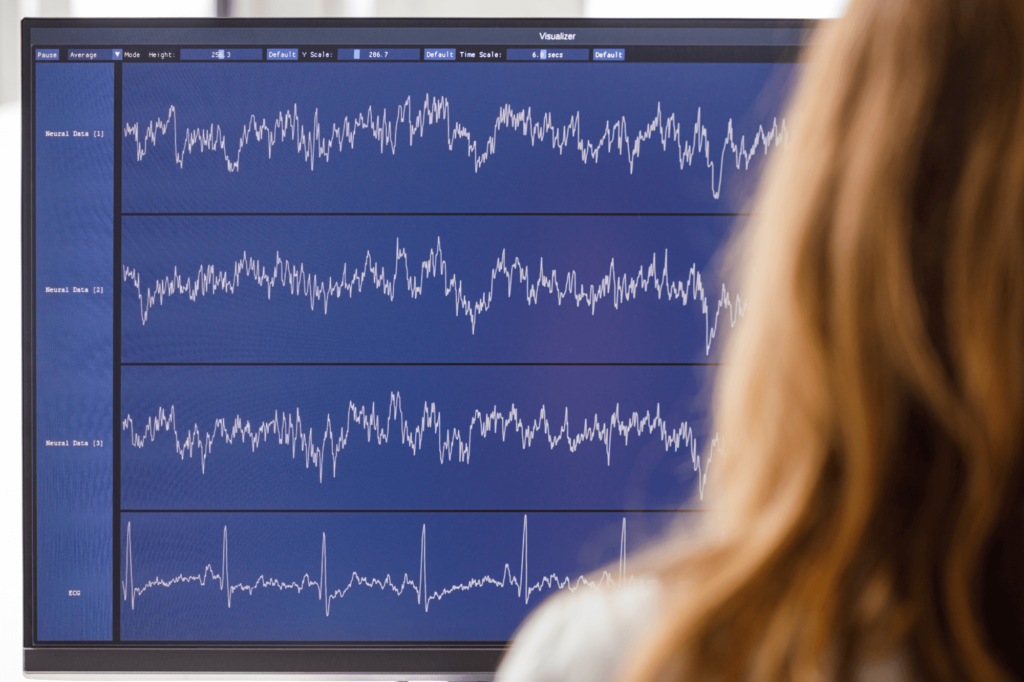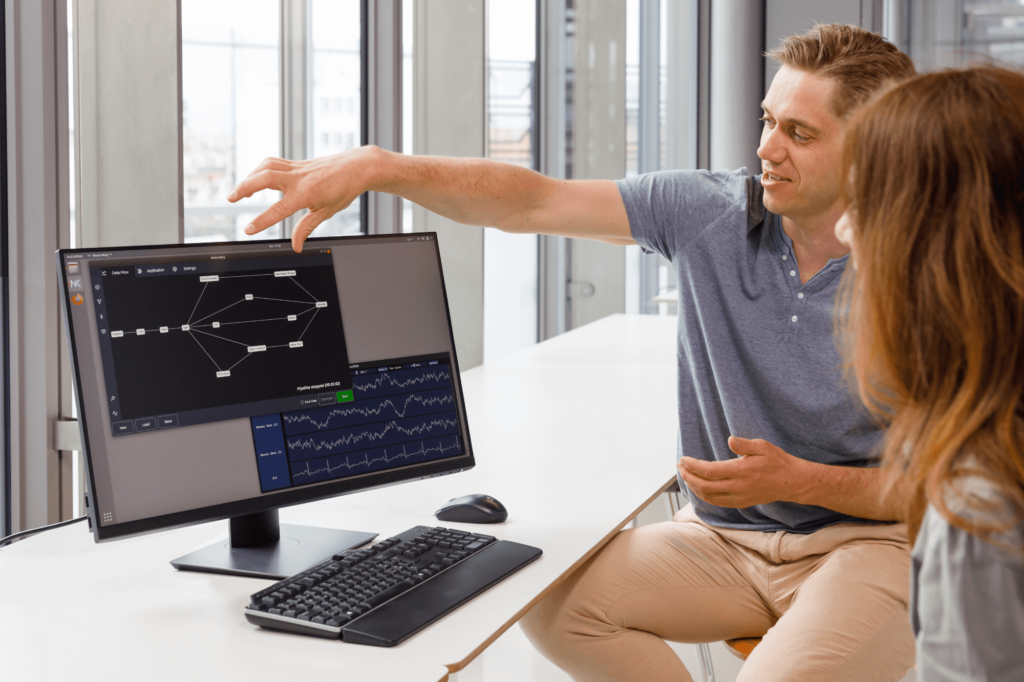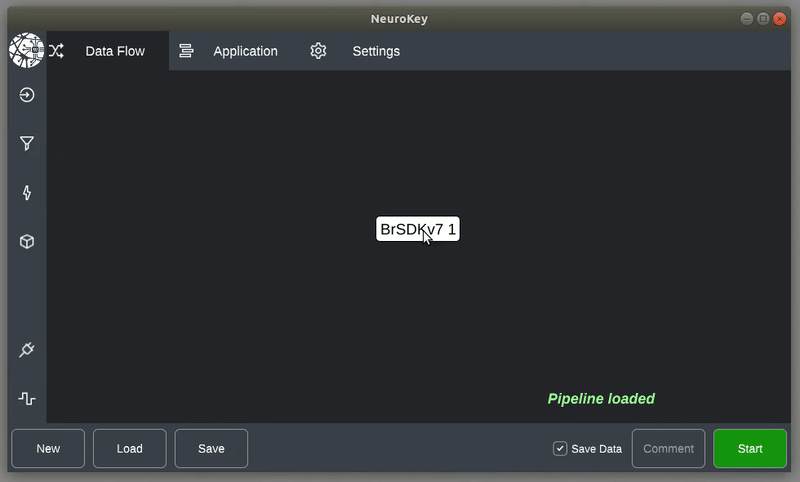Unlocking the power of neural data to drive human – machine interactions

Real-time, integrated, high throughput data

Seamless data integration

Fast application prototyping
About
NeuroKey
NeuroKeyTM is a software platform that combines and processes data from neurophysiological monitoring devices in real time, including brain-computer interfaces (BCIs)
With algorithms customized for each application, Neurokey extracts information from the signals collected and generates commands to control assistive devices that restore communication and that could enable mobility and independence for people with paralysis or other nervous system disorders.
Neurokey was developed by a team of neuroscientists, software engineers and data scientists at the Wyss Center for Bio and Neuroengineering in Geneva, Switzerland.
With its industrial and clinical collaborators, the team is continuously enhancing Neurokey to be able to interface with a wider range of neural and physiological data acquisition systems, whether implantable or non-invasive.
In parallel, NeuroKey BCI can be used to enable communication for patients in complete locked-in state in the clinic or at home.

“We see a lot of entrepreneurial creativity in the development of implantable hardware, yet software, the engine that is meant to drive the interaction between the hardware and the human in a specific application, still needs a lot of work. We strive to deliver robust, reliable and flexible software geared towards clinical use and shortened development cycles.”

David Ibanez, MSc, PhD, NeuroKey Senior Technical Lead

David Ibanez, MSc, PhD, Brain Machine Interface Scientist
Our vision
Unlocking the power of neural data to improve lives.

Neurokey is based on a modular software architecture of individual processing blocks that can be flexibly interconnected to tailor the design of complex algorithms for the processing of physiological data including neural activity.
It offers a convenient graphical block diagramming tool for developing custom real-time data processing pipelines. Its Software Development Kit (SDK) allows for controlled and secure access to all data generated within processing pipelines at every block in real-time.
NeuroKey value
proposition
Real-time, integrated, high throughput data
NeuroKey is optimized for use with high channel count and high sampling rate implantable devices while allowing for synchronous processing of other physiological data such as blood pressure and temperature. The platform incorporates modules for signal processing, feature extraction and classification including single neuron activation analysis, spectral analysis, connectivity and local field potentials.
Enables synchronous, multi-channel intracranial recordings, integrated with diverse physiological signals in clinical settings.
Fast application prototyping
NeuroKey enables visual design and simple integration of custom processing blocks to simplify and speed up the development of data postprocessing flows for specific applications. A software development kit (SDK) enables secure, controlled access to all data generated within processing pipelines at every block and in real-time.
Reduces set-up burden and enables rapid software code testing.
Seamless integration with neurosensing devices
In addition to implantable sensors, NeuroKey is designed to interface with multiple commercial or custom-made sensors and actuators in a simultaneous, scalable and synchronized way. The NeuroKey interface is seamless across device classes, manufacturers and brands.
Interfaces with a variety of signal acquisition and stimulation devices.
The
team
David leads the design and implementation of NeuroKey including the development of real-time data processing algorithms from multimodal physiological data. David brings experience in neural signal processing, non-invasive brain stimulation, closed-loop stimulation and artificial intelligence.
David Ibáñez Soria, MSc, PhD
Senior Technical Lead
Jorge is responsible for the software development of NeuroKey. Jorge has previously developed software for high-speed data acquisition systems and has wide experience in the development of medical devices including the application of quality standards in software development.
Jorge Barros, MSc
Software Lead
Valentin leads the implementation and compliance of the quality assurance processes for NeuroKey. Valentin has wide experience in quality assurance, risk management and design verification for high-risk active implantable medical devices.
Valentin Beslouin, MSc
Quality Assurance
Jonas brings experience in human and animal neuroscience working with fMRI, multielectrode array recordings, optogenetic and electrical stimulation, and EEG. He is involved in the development of advanced neural data processing algorithms to enable novel therapies and devices.
Jonas Zimmermann, PhD
Scientific Lead
Maxim has more than 15 years of experience in developing embedded and conventional software for scientific and industrial applications. He has previously worked in network and industrial imaging where he developed skills in programming languages, software architecture, testing and continuous integration.
Maxim Andersen, MSc
Hardware Integration Engineer
With more than 20 years experience in software development, Noah is an expert in C++, metaprogramming, Unix systems and Agile development. Noah has served as technical lead for several software projects of various kinds.
Noah Roberts
Senior Software Engineer
Arnau brings experience in neural signal processing, brain-computer interfaces and medical device regulation. He has a keen interest in advanced neural data processing algorithms, neuronal networks and neurorehabilitation devices. Arnau has previously worked in software development in research and industry settings.
Arnau Espinosa, MSc
Benefits of
NeuroKey
NeuroKey provides several benefits to industrial, clinical and research users
Industry
Reduce time-to-clinic for innovations
NeuroKey is a readily available, high-performing signal processing platform that can easily be integrated with pioneering technology developments. Its modular architecture and flexible design allow full customization to the innovator’s application and scalability for patient use.
Clinicians
Close the gap between thought and action
NeuroKey brings real-time biosignal decoding into clinical practice. Clinicians can integrate physiological data with powerful intracranial neural signals to advance the standard of care across neurological conditions and improve quality of life for patients.
Researchers
Invigorate research and advance science
Professionally developed and tested, NeuroKey offers an end-to-end platform for pipeline development and processing, data analysis and visualisation. User-friendly documentation and custom support empower researchers to focus on innovative research.
Development
pipeline
Use case
Design & development
Regulatory submission
In-market
Communication for CLIS*
NeuroKey BCI is currently in clinical use in Europe. It works directly with implanted intracortical microelectrode arrays with users aged 18 years and older in a completely locked-in state (CLIS) as a result of amyotrophic lateral sclerosis. NeuroKey BCI assesses online changes in single-neuron activation and voltage fluctuations coming from the synchronized activity of groups of neurons. Detected brain patterns feed a computational model that decodes the user’s intention into commands, sounds or letters. No contraindications have been identified when NeuroKey is used per its intended use in normal conditions of use. NeuroKey BCI is NOT intended to be used in patients with severe cognitive problems that interfere with the understanding of instructions. NeuroKey BCI shall only be used by operators trained by Wyss Center qualified representatives.
Stage: In-market
Closed-loop stimulation for hemodynamic control after SCI**
NeuroKey is under development for hemodynamic control during acute and chronic phases of SCI, where secondary damage control at injury site and risk of chronic cardiovascular disease need to be addressed. NeuroKey will use mean arterial pressure, spinal cord oxygenation and blood flow as biomarkers for real-time stabilization of neural communication pathways at site of injury (acute) as well as to drive spinal cord stimulation for closed-loop hemodynamics control (chronic).
Stage: Design & development
Other applications in development include stroke rehabilitation and movement restoration.
*Completely locked-in state in users with amyotrophic lateral sclerosis
** Spinal cord injury, acute and chronic phases